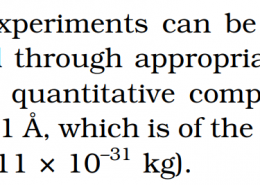Class 12 Physics
CBSE and UP Board
Dual Nature of Radiation and Matter
Chapter-11 Exercise 11.32
NCERT Solutions for Class 12 Physics Chapter 11 Question-32
Additional Exercise
(a) Obtain the de Broglie wavelength of a neutron of kinetic energy 150 eV. As you have seen in Exercise 11.31, an electron beam of this energy is suitable for crystal diffraction experiments. Would a neutron beam of the same energy be equally suitable? Explain. (mn = 1.675 × 10⁻²⁷ kg) (b) Obtain the de Broglie wavelength associated with thermal neutrons at room temperature (27 ºC). Hence explain why a fast neutron beam needs to be thermalised with the environment before it can be used for neutron diffraction experiments.
Share

Ans (a).
De Broglie wavelength = 2.327 x 10-12 m; neutron is not suitable for the diffraction experiment
Kinetic energy of the neutron, K = 150 eV = 150 x 1.6 x 10-19 = 2.4 x 10-17 J
Mass of a neutron ,mn=1.675 x 10-27 kg
The kinetic energy of the neutron is given by the relation:
K = 1/2 mnv2
=> mnv = √(2Kmn)
Where,v = Velocity of the neutron
mnv = Momentum of the neutron
De-Broglie wavelength of the neutron is given as:
λ =h/mnv = h/√(2Kmn)
It is clear that wavelength is inversely proportional to the square root of mass.
Hence. wavelength decreases with increase in mass and vice versa.
λ = (6.6 x 10⁻34)/√ [2(2.4 x 10-17)(1.675 x 10-27)]
= 2.327 x 10⁻¹² m
It is given in the previous problem that the inter-atomic spacing of a crystal is about 1 Aº, i.e., 10-10 m. Hence, the inter-atomic spacing is about a hundred times greater. Hence, a neutron beam of energy 150 eV is not suitable for diffraction experiments.
Ans (b).
De Broglie wavelength = 1.447 x 10-10 m
Room temperature, T = 27°C = 27 + 273 = 300 K
The average kinetic energy of the neutron is given as:
E= 3/2 kT
Where, k = Boltzmann constant = 1.38 x 10⁻23 J mol-1 K⁻1 The wavelength of the neutron is given as:
λ = h/√(2Emn) = h/√(3KmnT )
= (6.6 x 10⁻34)/√[3 x (1.675 x 10⁻27 )x (1.38 x 10⁻23 )x 300]
= 1.447 x 10⁻10 m
This wavelength is comparable to the inter-atomic spacing of a crystal. Hence, the high energy neutron beam should first be thermalised, before using it for diffraction.